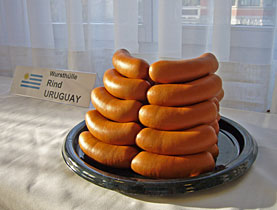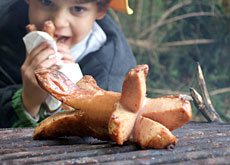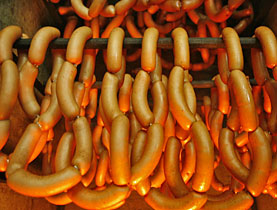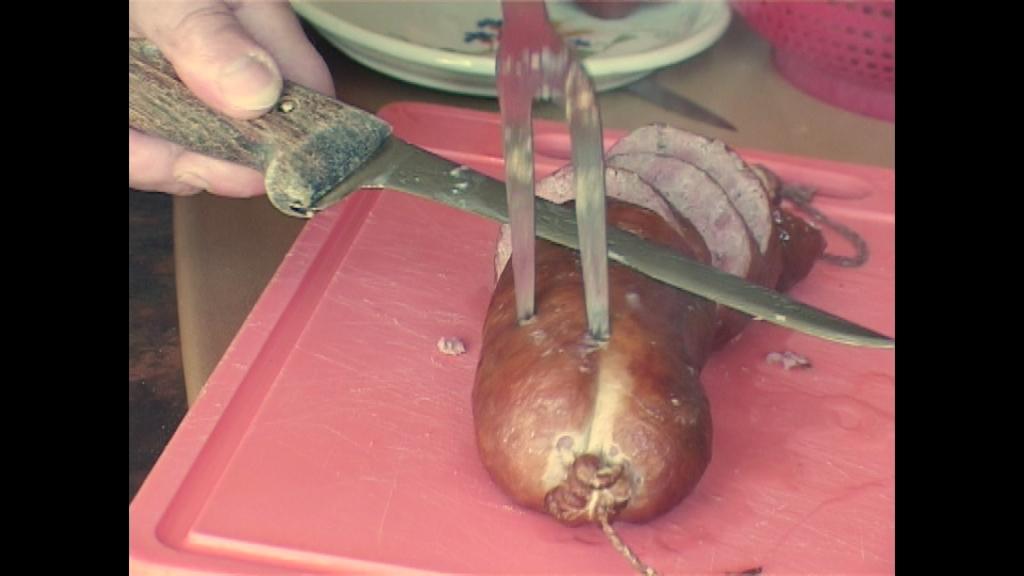The great sausage test

The lengths scientists went to trying to save the skin of the beleaguered national sausage show it is not just a culinary institution, but a precision product.
While Germany was happy to replace banned Brazilian skins with an alternative, the more exacting standards of the Swiss cervelat have defied all attempts to find a suitable skin replacement.
The cervelat was facing extinction from the national menu following an import ban on Brazilian cow intestines used to wrap the iconic sausage. Switzerland was compelled to adhere to European Union regulations safeguarding against the risk of Mad Cow disease.
But the versatile Brazilian product is a tough act to follow, both allowing the sausage to curve pleasantly when grilled and being easy to peel when eaten cold. The skin retains an aesthetically appealing colour and tastes good.
Up stepped scientists from the federal agricultural laboratory, the Agroscope Liebefeld-Posieux Research Station (ALP), to put replacement candidates through their paces.
Twelve different varieties of sausage skin from as far afield as China and Uruguay were tested for shape, colour, texture, peeling qualities, permeability, shrinkage and consistency.
“We used a sensory test but we also employed technology because we wanted our findings to be as objective as possible,” ALP researcher Ruedi Hadorn told swissinfo. “It was an extremely complicated process.”
One piece of machinery tested the skins’ ability to hold the sausage together by slicing through the meat and testing the resistance. Another kit measured how easy it was to peel the cervelat by gripping the skin and pulling with an exact resistance.
Mildly rancid
More conventional technology was applied to ensure the sausages conformed as closely as possible to the proper measurements of 20 centimetres in length and 32-32 millimetres in diameter.
The detailed observations taken during the experiments showed that the scientists were not easily impressed.
Chinese pig’s intestines produced the best colour, but disappointingly resulted in unacceptable variations in the size of the finished sausage.
One collagen skin produced practically straight sausages while artificial products did not colour in the right way when grilled. And seaweed skin did not accept metal clips used to close the sausages at each end.
Alarmingly, Argentinian cows’ intestines tasted “mildly rancid”, while another product burst so it “looked like a sausage when it was put on the grill, but more like a pizza when it was taken off”.
After exhaustive tests, Uruguayan cows’ intestines, pigs’ intestines from China and a collagen product were chosen as the only viable alternatives. But none of them were as good as the banned Brazilian skins.
“We see some solutions but they are not yet quite suitable for our standards. These would all be stopgaps and we would much rather stick with Brazil,” Balz Horber, a spokesman for the Swiss meat association, told swissinfo.
Good taste
But would the notoriously fickle Swiss consumer really care? Yes, said Horber – because the sausage means more than just a tasty snack. “It is not just a product because it also involves our emotions,” he explained. “Every Swiss child has been accompanied by this sausage as they grew up.”
Liselotte Steffen of the Swiss consumers’ forum agreed that the Swiss take more pride in their sausages than the Germans.
“The real expert does not eat sausages with mustard. In Germany they eat curry sausages with mustard which shows that they do not appreciate tastes in the right way,” she told swissinfo.
But the good news for the sausage making industry is that consumers will accept the new form of cervelat as long as the ingredients are clearly labelled, according to Steffen.
“I am sure that some consumers will be unhappy, but the vast majority will understand the situation. The Swiss consumer is very spoilt thanks to the high quality of products here. But I am sure they will get through this change.”
swissinfo, Matthew Allen in Zurich
The Swiss eat 160 million cervelat sausages every year – accounting for some 30% of all sausage output.
Every year meat from 120,000 cows and 360,000 pigs, 90 per cent of which is Swiss, is stuffed inside the skins.
The cervelat, also spelled cervelas, is eaten raw, fried or grilled.
The most popular way of cooking the sausage is speared on a stick over an open fire. Before cooking, people cut a cross at each end, so that they open up and curl back over the heat.
The name comes from the Latin cerebellum, meaning brain.

In compliance with the JTI standards
More: SWI swissinfo.ch certified by the Journalism Trust Initiative




You can find an overview of ongoing debates with our journalists here. Please join us!
If you want to start a conversation about a topic raised in this article or want to report factual errors, email us at english@swissinfo.ch.